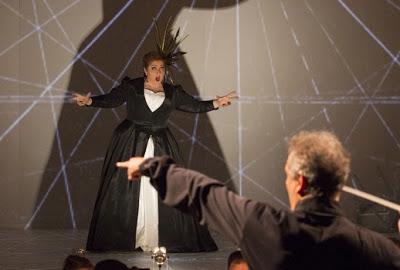by Paul J. Pelkonen

Burning down the house: Christine Goerke (center) sings Elettra in The Illuminated Heart
as Louis Langrée conducts. Photo © Richard Termine for Lincoln Center for the Performing Arts.
Each year, Mostly Mozart takes creative liberties with the dodgy acoustics of David Geffen Hall for its own needs. For this show, a second, smaller proscenium was constructed on the stage, brightening the sound in the theater and making it feel more like an opera house. Louis Langrée and the Mostly Mozart Festival Orchestra were demoted from the stage to an impromptu orchestra pit at the lip of the stage. Starting with the well-loved overture to Le Nozze di Figaro, they played with taut, urgent energy, leaping into their temporary role as an opera orchestra.
The program featured a starry array of singers, leapfrogging between six of the "big seven" Mozart operas, but (unaccountably) omitting Die Entführung aus dem Serail. (Its place was taken by an aria from the little-heard, unfinished opera Zaïde.) All the singing was done within the box, at once an acting surface and four-sided screen for the digital projections (by director Netia Jones) of imagery and surtitles that announced each number and accompanied the singers. As with the selections, some of these projections worked (the leaves for Die Zauberflöte, the gallery of silhouetted butterflies for Figaro) but others were dull, uninspired or just confusing.
Luckily there was no confusion regarding the septet of artists recruited for this performance. Peter Mattei, Christine Goerke, Christopher Maltman and Marianne Crebass led this glittering cast, showing that the current state of Mozart singing is very healthy indeed. Ana Maria Martinez and Daniela Mack led off as an engaging Fiordiligi and Dorabella, sharing the duet "A guarda, sorella" from Act I of Cosí fan tutte. They were swiftly followed by Mr. Maltman's Papageno, an engaging fellow who made one wish that one were about to enter the magic world of Die Zauberflöte for a greater length of time.
On it went. Peter Mattei sang the Count in Figaro for three scenes Matthew Polenzani was Don Ottavio, singing a gorgeous, almost hypnotic "Dalla su pace." Ms. Crebassa and Nadine Sierra shared the tender Sesto-Vitellia duet from La Clemenza di Tito, followed later by Ms. Crebassa singing the great "Parto, parto, ma tu, ben mio." Nadine Sierra soared in the Zaïde excerpt, making one wish that Mozart had finished that opera. Almost everyone was onstage for the finale from Act I of Cosí, with the boys in fezzes and false mustaches and the girls merely confused by their antics.
The highlight of the second half of the evening was a pair of excerpts from Idomeneo, the 1781 Mozart opera seria that may be the best example ever of that genre. The quartet "Andrò ramingo e solo" featured taut ensemble singing. Then, unaccountably, the opera was disrupted by Mr. Maltman, singing the "champagne aria" from Don giovanni. (Mr. Mattei, who sings this role regularly onstage at the Met, would have been preferable.) Ms. Goerke remained upstage during this bit of business, and then stepped forward.
Singing "O smania! O furie!," the soprano simply burned down the stage. She sang Elettra's aria with a ferocity and lack of inhibition that is usually reserved for full performances of operas. Her acting chops and intensity even outweighed the ridiculous Statue of Liberty headdress she was forced to wear, another poor costuming notion. She offered a thrilling performance, complete with jaw-dropping high notes as she called for "horned serpents" to tear out her heart. The climax was followed by another finale, the last scene of Figaro. However, following Ms. Goerke is a difficult thing to to, and this great reconciliation scene featuring the whole company seemed a little pallid.

